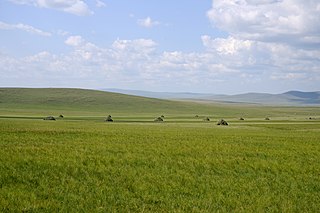
Inner Mongolia, officially the Inner Mongolia Autonomous Region, is an autonomous region of the People's Republic of China. Its border includes two-thirds of the length of China's border with the country of Mongolia. Inner Mongolia also accounts for a small section of China's border with Russia. Its capital is Hohhot; other major cities include Baotou, Chifeng, Tongliao, and Ordos.

Ningxia, officially the Ningxia Hui Autonomous Region, is an autonomous region in Northwestern China.
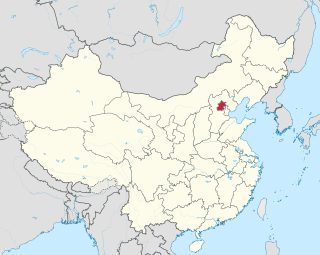
Beijing is a municipality located in North China at the northern tip of the North China Plain, near the meeting point of the Xishan and Yanshan mountain ranges. The city itself lies on flat land that opens to the east and south. The municipality's outlying districts and counties extend into the mountains that surround the city from the southwest to the northeast. The highest peaks are over 2,000 m (6,600 ft).
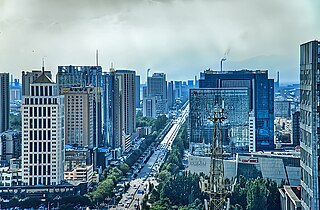
Baotou is the largest city by urban population in Inner Mongolia, China. Governed as a prefecture-level city, as of the 2020 census, its built-up area made up of its 5 urban districts is home to 2,261,089 people with a total population of 2,709,378 accounting for counties under its jurisdiction. The city's namesake, literally translated to "place with deer", is of Mongolic origin or "Lucheng", meaning "City of Deer". Alternatively Baotou is known as the "City of Steel in Gobi". Steel was a major industry in the city. Today, Baotou refines over half of the rare-earth minerals produced in the world. This has led to environmental contamination near the industrial sites.

Ulanqab or Ulan Chab is a region administered as a prefecture-level city in south-central Inner Mongolia, China. Its administrative centre is in Jining District, which was formerly a county-level city. It was established as a prefecture-level city on 1 December 2003, formed from the former Ulanqab League. The Ulanqab Stadium is located in the city.

Shizuishan, formerly Shizuizi, is a prefecture-level city in the Ningxia Hui Autonomous Region of the People's Republic of China. It is the northernmost prefecture in Ningxia and the second most populous, after the regional capital Yinchuan, bordered by Inner Mongolia to all directions except the south. Shizuishan sits on the western bank of the Yellow River on the western side of the Ordos Loop. It was formerly a center for caravans traveling the northern routes to and from Beijing across the Ordos Desert.

Wuzhong is a prefecture-level city in the Ningxia autonomous region of the People's Republic of China. It was known as Yinnan Prefecture before it was upgraded to a prefecture-level city in 1998. In 2019, Wuzhong had a population of 1.4 million. Wuzhong is located in the Northwest of China, with the Yellow River flowing through the center of the city.

A cashmere goat is a type of goat that produces cashmere wool, the goat's fine, soft, downy, winter undercoat, in commercial quality and quantity. This undercoat grows as the days get shorter and is associated with an outer coat of coarse hair, which is present all the year and is called guard hair. Most common goat breeds, including dairy goats, grow this two-coated fleece.
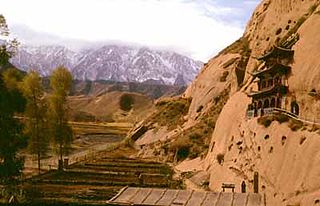
The Subei Mongol Autonomous County is an autonomous county within the prefecture-level city of Jiuquan in the northwest of Gansu Province, China, bordering Xinjiang to the west, Qinghai Province to the southeast and Mongolia's Govi-Altai Province to the north. Containing the northernmost point in Gansu, Subei is split into two non-contiguous sections and has an area of 66,748 km2 (25,772 sq mi) and had approximately 13,046 inhabitants in 2000. To the east it shares a border with Ejin Banner, Alxa League, Inner Mongolia.

Bayannur or Bayannao'er is a prefecture-level city in western Inner Mongolia, People's Republic of China. Until 1 December 2003, the area was called Bayannur League.
The Great Green Wall, officially known as the Three-North Shelter Forest Program, also known as the Three-North Shelterbelt Program, is a series of human-planted windbreaking forest strips (shelterbelts) in China, designed to hold back the expansion of the Gobi Desert, and provide timber to the local population. The program started in 1978, and is planned to be completed around 2050, at which point it will be 4,500 kilometres (2,800 mi) long.
The Beijing Weather Modification Office is a unit of the Beijing Meteorological Bureau tasked with weather control in Beijing, and its surrounding areas, including parts of Hebei and Inner Mongolia.

Ejin is a banner in the far west of Inner Mongolia, China. It is under the administration of Alxa League and is the westernmost county-level division of Inner Mongolia, bordering Gansu province to the west and Mongolia's Bayankhongor and Govi-Altai Provinces. Its seat is located at Dalaihob Town. To the west, it shares a border with Subei Mongol Autonomous County of Jiuquan, Gansu.

The 2010 China drought and dust storms were a series of severe droughts during the spring of 2010 that affected Yunnan, Guizhou, Guangxi, Sichuan, Shanxi, Henan, Shaanxi, Chongqing, Hebei and Gansu in the People's Republic of China as well as parts of Southeast Asia including Vietnam and Thailand, and dust storms in March and April that affected much of East Asia. The drought has been referred to as the worst in a century in southwestern China.

The Beijing–Lhasa Expressway, commonly abbreviated to Jingzang Expressway, is part of the Chinese national expressway network and is planned to connect the nation's capital, Beijing, to the capital of the Tibet Autonomous Region, Lhasa.
Shi Taifeng is a Chinese politician currently serving as the head of the United Front Work Department (UFWD) of the Central Committee of the Chinese Communist Party (CCP) and the first-ranking vice chairperson of the Chinese People's Political Consultative Conference (CPPCC). He is additionally a member of the CCP Politburo and a secretary of the CCP Secretariat.
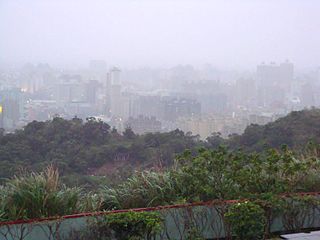
Air pollution in Taiwan is mostly derived from sources of domestic combustion, primarily the burning of fossil fuels. Taiwan's topography has been noted to be a contributing factor to its air pollution problem, leading to poor dispersal and trapping pollutants. Taipei, Taiwan's capital and largest city for example, is surrounded by mountains, and other industrial centers along the northern and western coasts of Taiwan are surrounded by high mountains.

Air pollution in South Korea is an increasing threat to people and the environment. The air pollution comes from many sources, both domestic and international. Many forms of pollution have increased in South Korea since its rapid industrialization, especially in Seoul and other cities. According to the U.S. National Aeronautics and Space Administration (NASA), Seoul is one of the world's cities with the worst air pollution. From 2009 and 2013, the city's mean PM10 were higher than in many of the largest metropolitan cities in the world such as: Los Angeles, Tokyo, Paris, and London. This has resulted in health and environmental problems. Koreans buy masks and air purifiers to breathe cleaner air, and are working to reduce the country's emissions.

Joseph Li Jing is a Chinese Catholic priest and Bishop of the Roman Catholic Diocese of Ningxia since December 20, 2009.
North Minzu University is a Chinese university located at Yinchuan City, Ningxia Province, China. It is a comprehensive national institution of higher education which is affiliated to the State Ethnic Affairs Commission. The university is authorized to grant bachelor's, master's and doctor's degrees approved by the Academic Degree Commission of the State Council. NMU is the only university at the central ministry and commission level that is established in an autonomous region, located in Yinchuan, the capital city of Ningxia Hui Autonomous Region. The university was founded in 1984 as Northwest Second Minzu University. In 2008, it was renamed to North Minzu University.

















